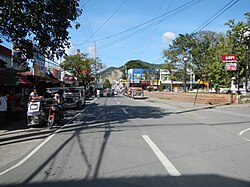Mabini, Batangas
| Mabini | ||
|---|---|---|
| Municipality | ||
 |
||
|
||
| Nickname(s): Diving Capital of the Philippines | ||
 Location within Batangas province |
||
| Location within the Philippines | ||
| Coordinates: 13°43′N 120°54′E / 13.72°N 120.9°ECoordinates: 13°43′N 120°54′E / 13.72°N 120.9°E | ||
| Country | Philippines | |
| Region | Calabarzon (Region IV-A) | |
| Province | Batangas | |
| District | 2nd District | |
| Founded | 1923 | |
| Barangays | 34 (see Barangays) | |
| Government | ||
| • Type | Sangguniang Bayan | |
| • Mayor | Nilo M. Villanueva | |
| • Vice Mayor | Elmar A. Panopio | |
| • Councilors |
Members
|
|
| Area | ||
| • Total | 44.47 km2 (17.17 sq mi) | |
| Population (2015 census) | ||
| • Total | 46,211 | |
| • Density | 1,000/km2 (2,700/sq mi) | |
| • Voter (2016) | 28,259 | |
| Time zone | PST (UTC+8) | |
| ZIP code | 4202 | |
| IDD : area code | +63 (0)43 | |
| Income class | 1st class | |
| PSGC | 041016000 | |
| Website | www |
|
Mabini, officially the Municipality of Mabini (Filipino: Bayan ng Mabini), is a municipality in the province of Batangas in the Calabarzon (Region IV-A) of the Philippines. The population was 46,211 at the 2015 census. In the 2016 electoral roll, it had 28,259 registered voters.
Mabini is known for its diving and snorkeling sites. It is named after Apolinario Mabini, a Filipino revolutionary hero.
Legend states that the first Malay settlers to inhabit the vast fertile land bordering the two bodies of water now known as the Batangas Bay and the Balayan Bay, first found anchor along the shores of the land protruding down Southwest ward known geographically as the Calumpan Peninsula.
These Malay settlers found the land fertile and agriculturally appropriate and the sea rich in marine resources. They established their settlement in this once vast unknown land. As more Malay settlers arrived from distant lands, more settlements were founded until even the upland regions of the peninsula were settled. The inhabitants had their own form of village government. They were ruled by a headman, a datu, or a sultan, in case of big encampments. Malay civilization began to take roots. Rapid increase of population brought about the settlements of all the neighboring regions, that it did not take long before several nearby regions were inhabited later on to comprise the whole province of Kumintang, better known later as Batangas.
During the Spanish colonial rule, the Calumpan Peninsula was made a part of the pueblo of Bauan, in the province of Kumintang. The same peninsula territory of Bauan was subdivided into barrios: Mainaga, Pulong-Niogan, Pulong-Balibaguhan, Anilao, Solo, Pulong-Anahao, Bagalangit, Nag-Iba, Malimatoc, Saguing and Talaga. For more than three hundred years, while the Archipelago was under Spanish domination, the peninsula remained a part of the “pueblo” of Bauan even until the early part of the American occupation. The people of this peninsula, like other people of other regions, suffered untold hardships under the Spanish rule. The yoke of the Spanish tyranny was thrown off after the gallant uprising of 1896. The revolution emancipated the people from the tyrants of Spain. Foremost of the heroic young men was Don Francisco Castillo, known as Apian Kiko, who led the fight for freedom in this peninsula.
...
Wikipedia


